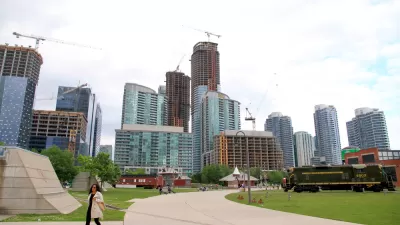Since it began in 1999, Toronto's condo boom has added 120,000 units to the city and, in the process, transformed its urban landscape. City leaders are just now beginning to address how to accommodate these new residents.
"In the last decade, the condo boom in Toronto has stacked the skyline with towers. Now, the approximately 250,000 to 275,000 people who live in them say that, in the race to build, city planners and councillors failed to adequately consider how to create neighbourhoods," reports Dave McGinn. "But the city is finally starting to listen."
“'I don’t think we anticipated, say, five years ago, or even before that, that this boom was going to continue,' says Peter Moore, project manager for the City of Toronto. Last month, the city launched the first of its kind series of public consultations to improve conditions for condo dwellers. The initiative is an acknowledgment that Toronto’s condo culture is here to stay." From poor condo construction to inadequate green space, participants' concerns extended from inside their units to the larger neighborhood.
“We need to be thinking much more extensively about … condos not as buildings but as part of a neighbourhood,” says Jennifer Keesmaat, the city’s chief planner. “We’re seeing a significant transition in the landscape and the form of the city at this moment that really is the impetus for us beginning to think in new ways about how neighbourhoods are defined in the city.”
FULL STORY: How can Toronto blend condos and community?

Alabama: Trump Terminates Settlements for Black Communities Harmed By Raw Sewage
Trump deemed the landmark civil rights agreement “illegal DEI and environmental justice policy.”

Planetizen Federal Action Tracker
A weekly monitor of how Trump’s orders and actions are impacting planners and planning in America.

The 120 Year Old Tiny Home Villages That Sheltered San Francisco’s Earthquake Refugees
More than a century ago, San Francisco mobilized to house thousands of residents displaced by the 1906 earthquake. Could their strategy offer a model for the present?

In Both Crashes and Crime, Public Transportation is Far Safer than Driving
Contrary to popular assumptions, public transportation has far lower crash and crime rates than automobile travel. For safer communities, improve and encourage transit travel.

Report: Zoning Reforms Should Complement Nashville’s Ambitious Transit Plan
Without reform, restrictive zoning codes will limit the impact of the city’s planned transit expansion and could exclude some of the residents who depend on transit the most.

Judge Orders Release of Frozen IRA, IIJA Funding
The decision is a victory for environmental groups who charged that freezing funds for critical infrastructure and disaster response programs caused “real and irreparable harm” to communities.
Urban Design for Planners 1: Software Tools
This six-course series explores essential urban design concepts using open source software and equips planners with the tools they need to participate fully in the urban design process.
Planning for Universal Design
Learn the tools for implementing Universal Design in planning regulations.
Clanton & Associates, Inc.
Jessamine County Fiscal Court
Institute for Housing and Urban Development Studies (IHS)
City of Grandview
Harvard GSD Executive Education
Toledo-Lucas County Plan Commissions
Salt Lake City
NYU Wagner Graduate School of Public Service



























